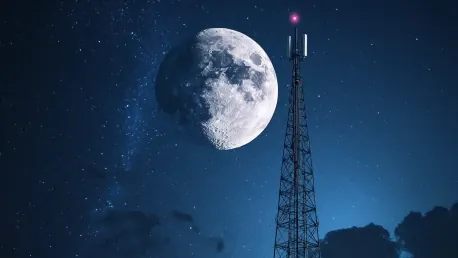Nokia Bell Labs and Intuitive Machines have achieved a groundbreaking milestone with the successful integration of Nokia’s Lunar Surface Communication System (LSCS) into Intuitive Machines’ Athena lander. This development is part of the IM-2 mission, which ambitiously aims to establish a cellular network on the Moon. This remarkable achievement underscores the culmination of months of rigorous testing and meticulous integration, positioning Nokia’s cellular network technology for deployment on the lunar surface. This advancement signifies a transformative leap in space communications, setting the stage for more significant developments in extraterrestrial connectivity.
Nokia’s Lunar Surface Communication System (LSCS)
Nokia’s LSCS, often described as a ‘network in a box,’ has become an integral part of the Athena lander. The system is securely affixed to Athena’s upper carbon-composite panels, a strategic move supported by multiple precautions ensuring resilience throughout the 239,000-mile journey to the Moon. Notably, thermal isolation at each of the 14 mounting points serves to shield the network from the extreme temperatures encountered in space. This intricate engineering ensures that the lunar environment’s harsh conditions do not compromise the integrity of the network.
The engineering efforts encompassing the LSCS extend beyond merely providing thermal protection. The network has been deftly integrated into the Athena lander’s Thermal Protection System, which ingeniously expels heat during network operation and supplies heat when the network is idle. This innovative approach guarantees that the network is well-prepared to endure the relentless demands of the lunar environment, thereby enhancing the viability and longevity of the communication system on the Moon’s surface.
Integration with Lunar Mobility Vehicles
In a bid to extend connectivity further, modules of the LSCS have been incorporated into lunar mobility vehicles, specifically Intuitive Machines’ Micro-Nova Hopper and Lunar Outpost’s Mobile Autonomous Prospecting Platform (MAPP) rover. These vehicles, upon successful landing, will deploy and establish connections to the network based on the Athena lander. This initiative is designed to demonstrate that cellular technologies can offer reliable, high-capacity, and efficient connectivity for future lunar missions, thereby paving the way for sustained extraterrestrial exploration and operations.
The network operates using a modified version of 4G/LTE cellular technology, adapted to address the unique challenges of the Moon’s environment. It is engineered to handle a variety of tasks, including high-definition video streaming, command-and-control communications, and telemetry data exchange between the vehicles and Athena. The data gathered on the Moon will be transmitted back to Earth through a direct-to-Earth transmission service, ensuring seamless communication and data transfer across vast distances.
Mission Objectives and Scientific Exploration
This mission by Intuitive Machines, marking their second lunar endeavor, also aims to test new sensor instruments utilizing the Micro-Nova Hopper and the LSCS. One primary objective is to search for invaluable resources on the Moon, such as water ice. This is achieved by adeptly scanning permanently shadowed lunar craters for substantial concentrations of hydrogen, which serve as indicators of ice deposits. The gathered data will be transmitted over Nokia’s network to Athena and then relayed back to Earth for comprehensive analysis, thus contributing to our understanding of lunar resources.
Simultaneously, the MAPP rover will focus its efforts on meticulously mapping the south pole region of the Moon, collecting stereo imagery and essential environmental data. This activity aligns with the broader strategy to establish the effectiveness of cellular technology on extraterrestrial bodies, with an eye on setting a precedent for future explorations, including potential missions to Mars. This approach ensures a holistic effort in leveraging cellular technologies to bolster scientific exploration and establish reliable communication frameworks beyond Earth.
Perspectives from Industry Leaders
Thierry E. Klein, President of Bell Labs Solutions Research at Nokia, offers a compelling perspective on the transformative potential of cellular technologies beyond Earth. He underscores that such technologies have not only revolutionized our communication methods on Earth but also hold the promise to redefine communication dynamics on other worlds. This significance extends to the technological innovations that aim to bridge communication gaps in space, thereby enabling more fluid and reliable exchanges as humanity expands its reach beyond Earth.
Steve Altemus, CEO of Intuitive Machines, elaborates on the broader implications by describing the delivery of Nokia’s 4G/LTE system on the lunar surface as a pivotal moment for space commercialization and the evolving lunar economy. Altemus emphasizes the innovative strides being introduced, which are likely to become key capabilities defining the Artemis generation under NASA’s guidance and concerted efforts. This initiative not only exemplifies technological prowess but also underscores the critical role of advanced communication systems in supporting sustained lunar operations and explorations.
Future Prospects and Broader Ambitions
Nokia Bell Labs and Intuitive Machines have reached a historic milestone with the successful integration of Nokia’s Lunar Surface Communication System (LSCS) into Intuitive Machines’ Athena lander. This achievement is a critical component of the IM-2 mission, which ambitiously aims to establish a cellular network on the Moon. This landmark accomplishment highlights the culmination of months of rigorous testing and precise integration, positioning Nokia’s advanced cellular network technology for deployment on the lunar surface.
The integration of Nokia’s LSCS with the Athena lander isn’t just a technical feat; it represents a transformative step forward in space communications. By advancing lunar connectivity, this partnership sets the stage for future developments in extraterrestrial communication systems. This pioneering effort not only enhances our ability to communicate over vast distances in space but also lays the groundwork for more advanced missions beyond our planet, marking a significant leap in the field of space exploration and extraterrestrial connectivity.









